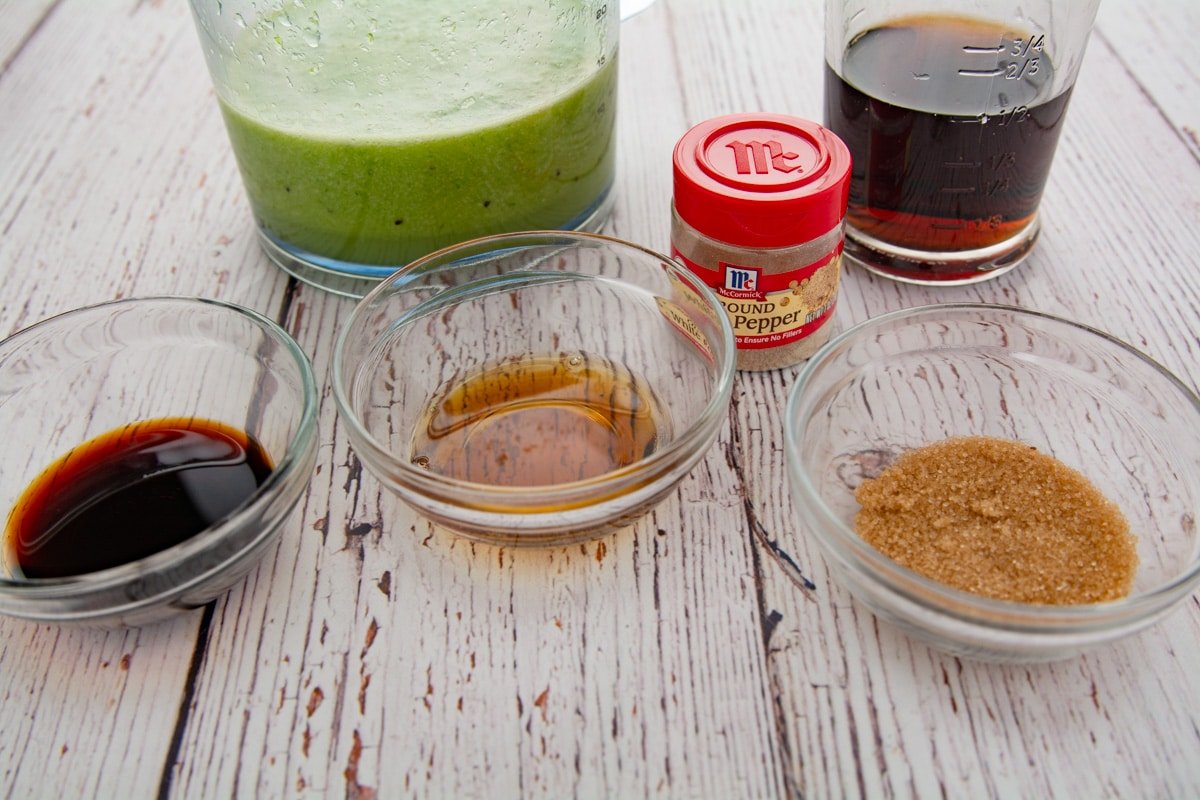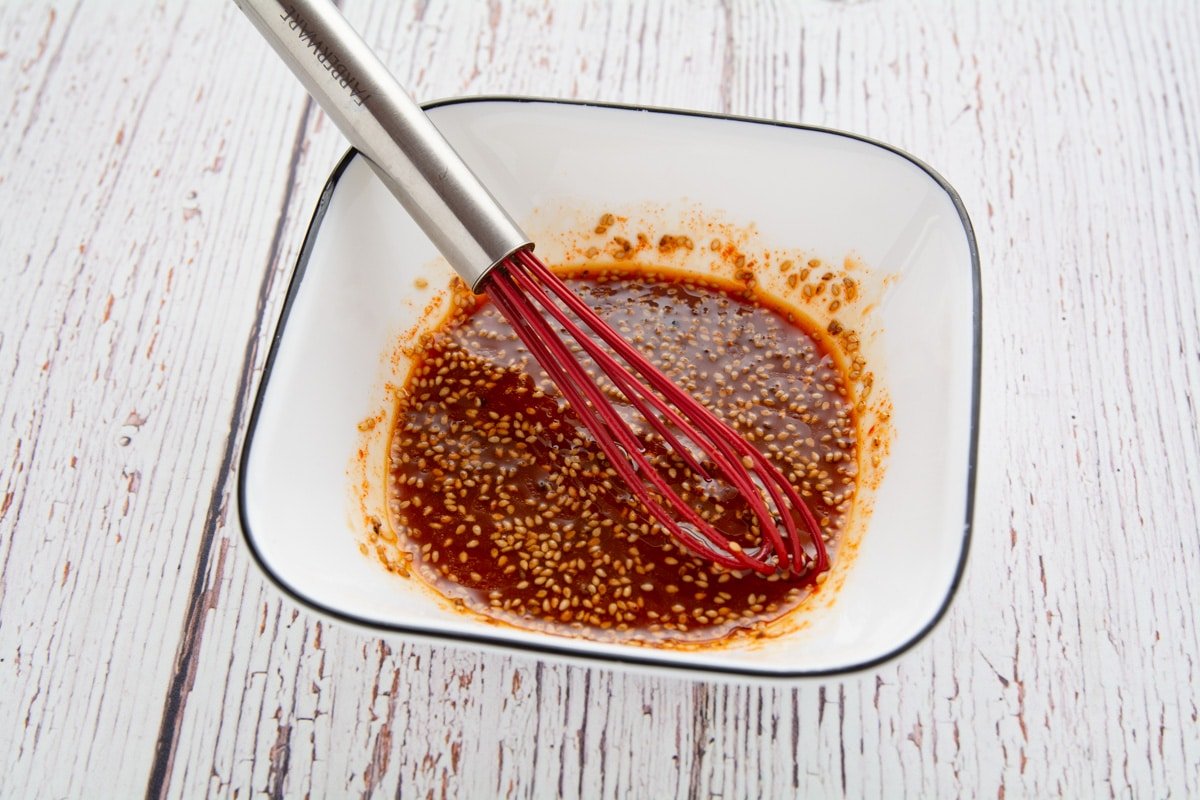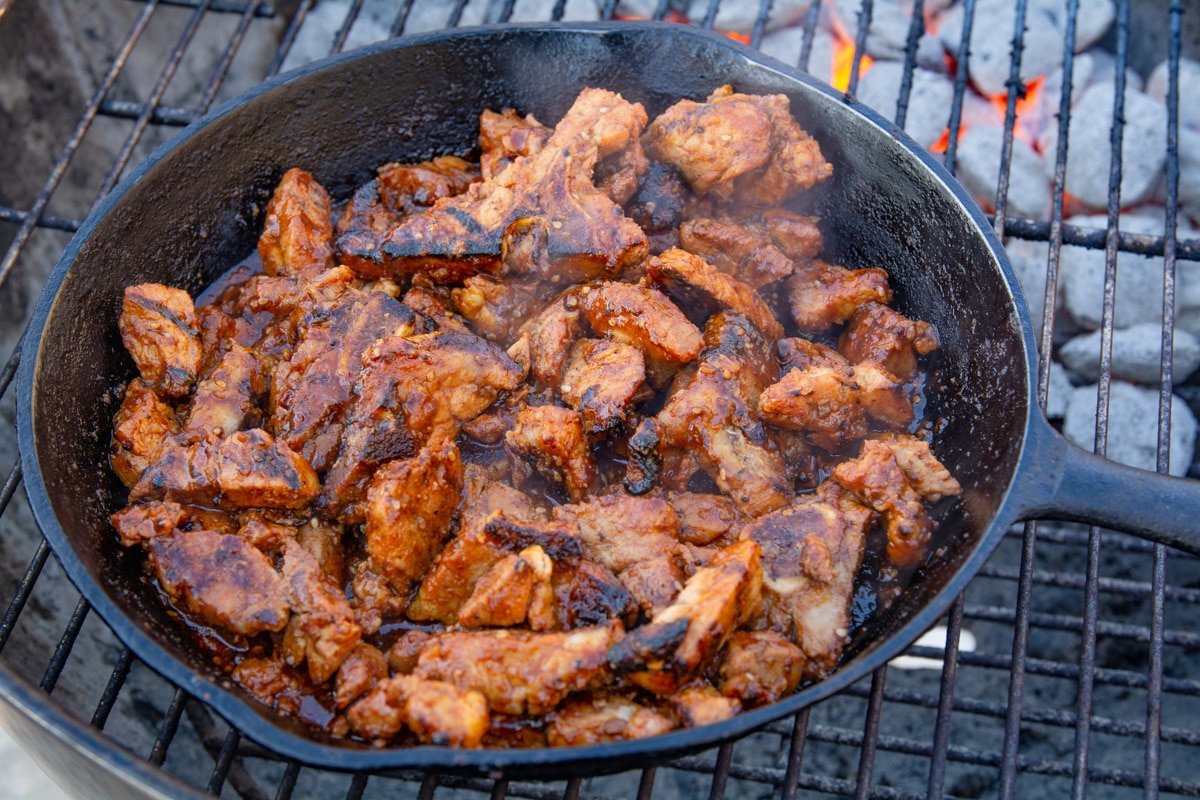Dwaeji bulgogi (spicy grilled pork) is usually cooked at the table, but we use a charcoal grill and cook it outside in this version. We lose the communal aspect of a Korean dish cooking it this way, but it’s still delicious.
Let me say this right off the bat. This is not a gout-friendly recipe. In fact, there is nothing healthy about this recipe. It’s fatty meat, and the marinade and sauce have too much sugar. However, this recipe is extremely delicious. A few days ago, my wife asked me to make it. After checking my uric acid level, I agreed.
The marinade is usually made with Korean pear. To me, the Korean pear is like a cross between pear and apple. It is added to the marinade for fruitiness and to tenderize the meat.

Marinade:
Green onion: I like to use three or 4. But it will turn the marinade green.
Garlic: The marinade needs garlic. The picture is of two huge cloves, but the recipe will show four. If your garlic is normal-sized garlic, you will need four.
Ginger: Ginger helps with the smell of pork. I used two slices and I remove the skin.
Fruit: Today I used kiwi but pear or apple will also work. Kiwi has Actinidain which acts as a meat tenderizer.
Water: This is just to increase the volume to cover the meat.
Place all of the above ingredients into a blender or food processor and blend. For this batch, I used an immersion blender.

To our pretty green marinade we will add:
Brown sugar: For sweetness and flavor.
Sesame oil: For flavor
Soy sauce: For saltiness and flavor.
White pepper: I used white but you can use black pepper.
Cola: Cola has sweetness and helps to tenderize the meat.
Give the marinade a good mix and it is ready.

For our meat, we used pork steaks. Pork shoulder, pork neck, or pork butt can also be cut into thin slices. But any fatty cut of meat like pork belly etc. will work. I tend to avoid lean cuts like tenderloin but if you are worried about calories a lean cut can work.
To help the marinade quickly penetrate, we cut slits about half the way thru the meat. We did this every quarter to half an inch. After cutting slits into the first side, the steaks were flipped over and turned ninety degrees. Then we made slits half the way thru on the opposite side of the steaks.
After cutting slits into the first side, the steaks were flipped over and turned ninety degrees. Then we made slits half the way thru on the opposite side of the steaks.

After cutting slits into the steaks, we placed them into a large bowl and covered them with the marinade. The steaks were marinated in the fridge for four hours. You can marinate the pork overnight.
You can freeze extra marinated pork for later. From this batch, we froze two of the pork chops. My wife cooked them later on the stovetop and was happy with them.

Spicy sauce: This is really the star of the show. When this sauce starts to caramelize you could put it on anything.
Garlic: Yep more garlic.
Sesame oil: More of this also.
Soy sauce: Yep
Brown sugar: Yep
Korean red pepper paste: Gochujang will bring lots of flavor and spiciness.
Water: Just thin out the sauce while it cooks into the meat.
Optionally you can add Korean red pepper flakes or gochugaru (for heat), mirin (sweet rice wine), sesame seeds,

Place all of the spicy sauce ingredients into a bowl, stir and set aside.
How should you cook your spicy Korean pork?
Normally in Korea, a Korean BBQ restaurant will sit you at a small table with a grill in the middle. Nowadays gas grills are the most common but the best BBQ places still use charcoal grills but they make your clothes smell like smoke and grease.
This is a video I made on a trip to Korea in 2015 of a standing BBQ place. It was as no-frills as you can get. They only sold meat (only one cut), beer, and soju. It was some of the best Korean BBQ I have ever had.
At home, you have a few choices for cooking your bulgogi recipe:
Stovetop, you can cook your Korean pork bulgogi on your stovetop in your regular pans. It’s not the ideal choice but it works and nothing special is required.
Portable electric grills, allow you to safely cook indoors without filling your home with exhaust fumes.
Portable gas grills, allow you to cook indoors very similar to the gas grills inside without smoking up the place. However, you will need to keep a window or door open to let the fumes escape.
If you have an outdoor grill you can cook the pork outside. In my case, I used a charcoal grill. This allows you to add smoke flavor to your Korean spicy pork.
You may have noticed that I add marinade to the dish before cooking but I have not added the spicy sauce. The spicy sauce has a lot of sugar that can easily burn. When cooking on an open fire I prefer to add it after searing the meat.

Build a fire on one side of the grill. Place a cast-iron skillet on the other side. This will allow the skillet to start to warm up. Place the pork steaks directly over the flame. To prevent burning you will need to keep an eye on them, when they are exposed to high heat they can burn quickly.

Give the pork steaks a little char on both sides. At this point, it is now pork bulgogi.

Cut the pork steaks up into bite-sized pieces, and place them into the skillet. Move the skillet over the flames and add the spicy sauce. Stir and cook until the liquid is almost gone and move to the cold side of the grill.

Keep stirring and cooking until the sauce is thick and stuck to the meat. At this point, it should be slightly caramelized. The spicy pork bulgogi is now ready to serve.
Normally it is served with lettuce and perilla leaves for wrapping with ssamjang, chili Normally when served you make a lettuce wrap with perilla leaves for wrapping with ssamjang, Korean chili paste, chili peppers, and kimchi. It’s kind of like eating the Korean version of tacos. Do not forget a bowl of rice and side dishes or banchan. Cucumber salad and this spinach side dish would be perfect with your dwaeji bulgogi.


Ingredients
Marinade
- 3 Green onions
- 4 cloves Garlic
- 2 slices Ginger
- 1 Kiwifruit
- 1/2 cup Water
- 1 Tablespoon Brown Sugar
- 1/2 teaspoon Sesame Oil
- 1 Tablespoon Soy Sauce
- 1 pinch White Pepper
- 1/2 cup Cola
Meat
- 3 Pounds Pork Steak
Spicy Sauce
- 2 Tablespoons Gochujang
- 1 Tablespoon Sesame seeds
- 1/4 cup Water
- 1 teaspoon Brown sugar
- 1 teaspoon Garlic finely minced
- 1 teaspoon Sesame oil
- 1/2 Tablespoon Soy sauce
Instructions
Prepare the Marinade
- Add green onion, garlic, ginger, kiwi, and water to a blender and blend.

- To the blender, add brown sugar, sesame oil, soy sauce, white pepper, and cola. Mix to combine.

Marinade the pork
- Lay the pork steaks out, and every 1/4 to 1/2 inch, cut half the way thru the meat.
- Flip the pork steaks over and rotate 90 degrees. Every 1/4 to 1/2 inch, cut half the way thru the meat.

- Place the meat into a large bowl and pour the marinade over the meat. Turn the steaks over to ensure that the marinade contacts all of the meats surface.

- Let the meat marinate for at least one hour.
Spicy Sauce
- To a bowl, add gochujang, sesame seeds, water, brown sugar, garlic, sesame oil, and soy sauce. Mix and set aside.
Cooking
- With your charcoal on one side of your grill, get a fire started.
- When the grill is hot place, a cast iron pan on the cold side.

- Place your pork steaks onto the grill directly over the coals. Please give them a good sear with a few charred spots on both sides.

- Remove from the grill and cut them up. Place them into the cast iron pan. Move the pan over the flame. Please pour the spicy sauce into the pan.

- Toss the pork with the sauce. Continue to cook while stirring to prevent burning; when most of the liquid has evaporated, move the pan back to the cold side of the grill.
- Continue to cook and continue to stir until the sauce has come caramelization. It's now time to serve.
